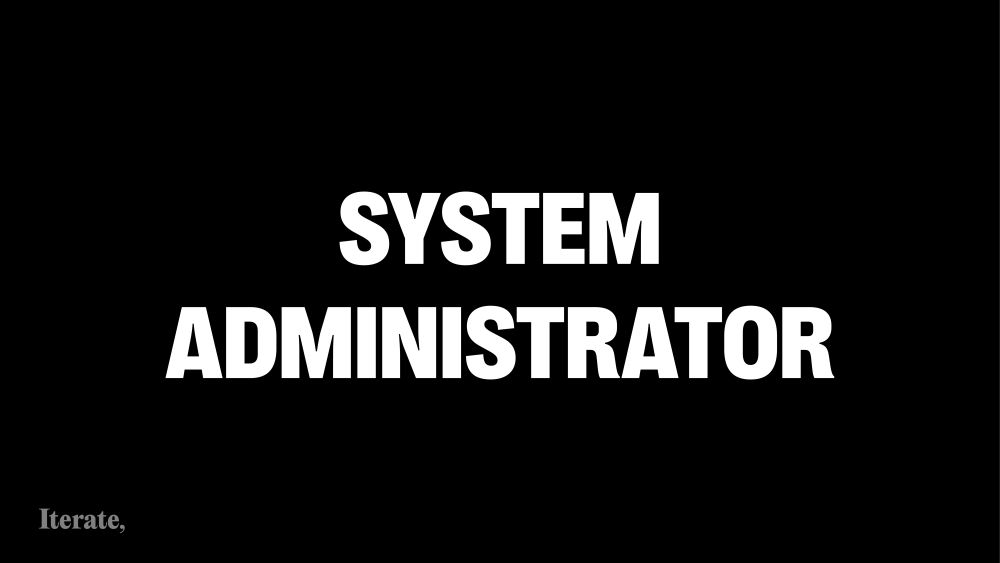Table of contents
Discover the role of a system administrator and learn what their daily tasks look like, what the job requirements typically are, and how to hire the best in the field.

What is a System Administrator?
System administrators are responsible for designing, implementing, maintaining, and troubleshooting the hardware, software, and networks in an organization's technology infrastructure. They ensure that all systems are operating efficiently and securely, and are the first line of defense against cyber threats and security breaches.
Additionally, system administrators also play a key role in disaster recovery planning, ensuring that critical data and systems can be quickly restored in the event of a disaster. A skilled system administrator is an invaluable asset to any organization, and recruiting the right person for this role can have a significant impact on the success of an organization's IT initiatives.
At The Org, we believe in increasing transparency in recruitment and hiring. That’s why we strive to make it easier for top talent to find where they fit in. Explore more than 400,000 organizations, and stay up to date with open positions with The Org.
How Much Do System Administrators Make?
The annual salary of a system administrator can vary depending on several factors, including location, industry, level of experience, and specific job responsibilities. According to data from the Bureau of Labor Statistics, the median annual salary for network and computer systems administrators in the United States as of May 2021 was $80,600. However, salaries for system administrators can range from approximately $50,000 for entry-level positions to over $120,000 for senior-level roles.
It's important to keep in mind that compensation packages for system administrators can also include benefits such as healthcare, retirement plans, and paid time off. If you’re hoping to attract top talent, it's important to offer a competitive salary and benefits package that reflects the value of the skills and experience that the candidate brings to the role.
What Are the Job Requirements of a System Administrator?
The job responsibilities of a system administrator can vary depending on the organization and specific role. Generally, however, they are as follows.
- Designing, installing, configuring, and maintaining an organization's computer systems and networks.
- Ensuring that hardware and software systems are operating effectively and securely.
- Performing regular system backups and updates.
- Troubleshooting any issues that arise.
- Managing user accounts, permissions, and access controls.
- monitoring system performance and security.
- Disaster recovery planning and ensuring that critical data and systems can be quickly restored in the event of an outage.
System Administrators in the Wild
It’s one thing to know the requirements of a role — it’s another to see what that role looks like in the wild. At The Org, we believe that putting a face to the job title and seeing for yourself where the role fits into the company makes it much easier to picture yourself in it.
Where in the company hierarchy does system administrators fit in? Who are their closest team members, and who do they report to? What career growth opportunities does system administrators have within the company structure?
We’re here to help you answer those questions. Explore live positions for system administrators and see the role in the wild here.
Tips for Hiring System Administrators
Recruiting system administrators can be a daunting task for many organizations, as these professionals play a crucial role in maintaining the IT infrastructure. Not only that, but they’re also essential for ensuring the smooth operation of business-critical applications. However, with the right approach, it is possible to attract top talent and build a strong IT team that can drive innovation and deliver value to the business.
When it comes to hiring a system administrator, there are a few less common, expert tips that can help you identify the best candidate for the role. Continue reading to learn more.
- **Search outside your traditional candidate pool. **While it's important to look for candidates with relevant technical expertise and experience, candidates with diverse backgrounds and skill sets can bring new perspectives and ideas to the role.
- **Review relevant job descriptions at top companies. **By gaining some insight into the types of candidates top companies in your industry seek, you can begin assessing candidates with similar skill sets, experience, and values.
- **Understand the difference between system administrator and system engineer. **While the roles of system administrator and system engineer are similar, it’s important not to mix up the two. While system administrators are responsible for managing the support of systems and networks, system engineers are in charge of designing and implementing said systems.
- **Frequent institutions of higher learning. **It can be ideal to visit college and university job fairs, viewing them as “farm teams” in which your company nurtures future talent. Then, you might consider offering tips and insight for curriculum, as well as providing internships to promising students. In the end, you can make a permanent offer to the most promising student.
Recruiting the best system administrator requires a thorough evaluation of technical skills, business acumen, communication, collaboration, and alignment with the organization's goals. Only then can your IT department function seamlessly.
At The Org, we believe traditional recruiting is in need of a refresh. Candidates want to know who they’ll work with, not just what they’ll do. Workplace culture, interpersonal relationships, and company values are more important now than ever.
And what better way to showcase your company’s unique culture than through your Org Chart?
Highlight different teams in your organization, the people that make these teams great, and show candidates how they fit into the big picture.
Your Org Chart is a novel and effective way to show candidates where they fit in, and to show off your greatest asset: your people.
Explore Org Charts here, and sign up today to create your own customized Org Chart for your company.


The ORG helps
you hire great
candidates
Free to use – try today